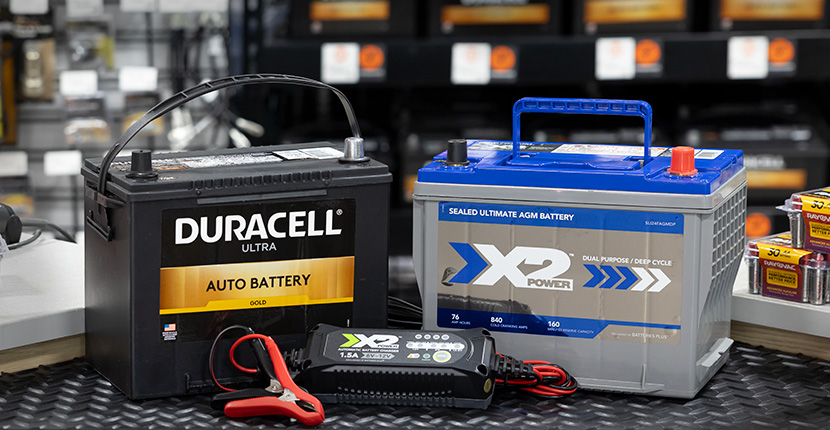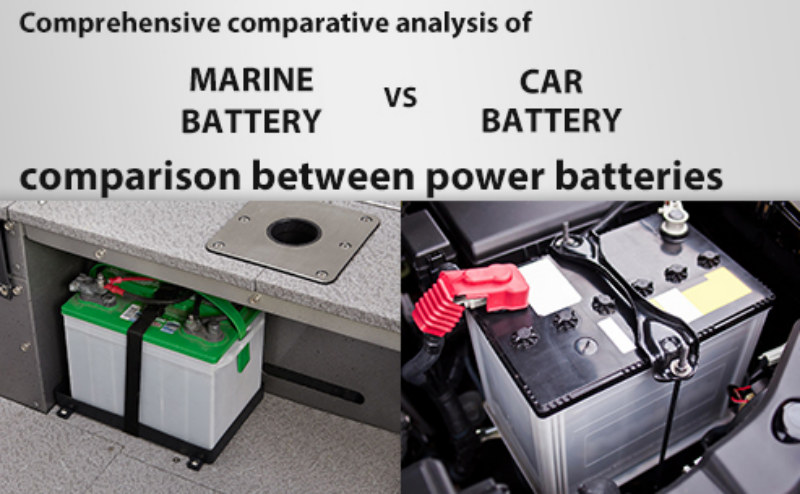Many of us getting little bit confustion between marine and car battery. They don’t know what’s the difference between marine battery and car battery. Let me explain, a marine battery is designed for boats and watercraft, offering deep-cycle capabilities. A car battery is built for quick, high-current bursts to start engines.
Marine batteries and car batteries serve distinct purposes. Marine batteries power boats and other watercraft, requiring deep-cycle capabilities to provide sustained power over long periods. They are built to withstand harsh marine environments, including vibrations and moisture. Car batteries, on the other hand, are optimized for vehicles on land.
They deliver short, high-current bursts to start engines and recharge quickly through the vehicle’s alternator. Understanding these differences is crucial for choosing the right battery for your needs, ensuring optimal performance and longevity. Always select a battery that matches your specific application to avoid potential issues.
Basic Concepts
Understanding the difference between a marine battery and a car battery is essential. They serve different purposes and have distinct features. This section will cover the basic concepts to help you grasp these differences.
What Is A Marine Battery?
A marine battery is designed for use in boats and other marine vehicles. It is built to withstand harsh conditions like vibrations and moisture. Marine batteries have thicker plates to handle deep discharges. They can power various accessories, such as lights and fish finders.
There are different types of marine batteries:
- Starting Batteries: Used to start the boat’s engine.
- Deep Cycle Batteries: Provide power over a long period.
- Dual-Purpose Batteries: A combination of starting and deep cycle batteries.
What Is A Car Battery?
A car battery is designed to start the engine of a car. It delivers a high burst of power for a short time. Car batteries are not designed for deep discharges. They recharge quickly through the vehicle’s alternator.
Key features of car batteries include:
- Cranking Amps (CA): Measures the battery’s ability to start an engine.
- Cold Cranking Amps (CCA): Measures the battery’s ability to start an engine in cold temperatures.
- Reserve Capacity (RC): Indicates how long the battery can supply power if the alternator fails.
Here is a table summarizing the key differences:
| Feature | Marine Battery | Car Battery |
|---|---|---|
| Purpose | Boats and marine vehicles | Cars and automotive vehicles |
| Design | Thicker plates for deep discharge | Thinner plates for high bursts of power |
| Durability | Handles vibrations and moisture | Designed for stable conditions |
| Types | Starting, Deep Cycle, Dual-Purpose | Standard automotive battery |
Construction Differences
Understanding the construction differences between marine batteries and car batteries helps to select the right one. These differences affect their performance, durability, and usage. Let’s explore the key construction differences.
Design And Build
Marine batteries and car batteries have distinct designs and builds. Car batteries are designed for short, high-current bursts. This helps start the engine quickly. Marine batteries, on the other hand, are built to provide a steady flow of power for a longer period. This supports boat electronics and equipment.
Car batteries are usually lighter and more compact. They fit snugly under the car hood. Marine batteries are typically larger and heavier. They are designed to withstand harsh marine environments.
Materials Used
The materials used in marine batteries differ from those in car batteries. Car batteries commonly use thinner lead plates. This design supports high-current output but has shorter life spans.
Marine batteries use thicker lead plates. This design allows for deeper discharges and longer-lasting power. Additionally, marine batteries often have reinforced cases. These cases protect against vibrations and shocks in a marine setting.
Marine batteries may include added elements like fiberglass mats. These mats provide extra durability and resistance to marine conditions. Car batteries do not usually have such reinforcements.
| Aspect | Car Battery | Marine Battery |
|---|---|---|
| Primary Use | Starting the engine | Powering boat electronics |
| Lead Plate Thickness | Thinner plates | Thicker plates |
| Weight | Lighter | Heavier |
| Durability Features | Basic casing | Reinforced casing, fiberglass mats |
Understanding these construction differences ensures you choose the right battery for your needs. Whether for a car or a boat, the right choice enhances performance and longevity.
Performance Characteristics
Understanding the performance characteristics of marine and car batteries is crucial. Both types of batteries serve different functions. They are designed to meet specific needs. Let’s dive into the key performance aspects.
Energy Storage
Marine batteries and car batteries store energy differently. Car batteries are designed for short bursts of energy. They help start the engine. Marine batteries, on the other hand, store energy for long-term use. They power devices on boats for extended periods.
Here is a table to summarize their energy storage capabilities:
| Type of Battery | Energy Storage Capacity |
|---|---|
| Car Battery | Low capacity, quick discharge |
| Marine Battery | High capacity, slow discharge |
Discharge Rates
The discharge rate is a key difference. Car batteries discharge energy quickly. This is to crank the engine. Marine batteries discharge energy slowly. They provide a steady flow of power.
Here are some key points:
- Car Batteries: High discharge rate, short duration
- Marine Batteries: Low discharge rate, long duration
Discharge rates affect battery life. Car batteries have a shorter life due to quick discharge. Marine batteries last longer because of slow discharge.
Durability And Lifespan
You have to check the durability and lifespan of batteries, which is very important. Marine and car batteries serve different purposes. Their longevity and durability vary significantly.
Marine Battery Longevity
Marine batteries are built to withstand harsh conditions. They endure vibrations and constant movement. They are designed for deep cycles and frequent discharging.
Marine batteries use thicker plates. These plates extend their lifespan. A well-maintained marine battery can last up to 7 years.
Factors affecting marine battery longevity:
- Usage frequency
- Maintenance practices
- Storage conditions
Car Battery Lifespan
Car batteries provide short bursts of energy. They start the engine and then get recharged by the alternator.
Car batteries typically last between 3 to 5 years. Their lifespan depends on several factors:
- Climate conditions
- Driving habits
- Maintenance routine
Extreme temperatures can shorten a car battery’s life. Regular checks and proper maintenance are essential.
Applications
Understanding the applications of marine batteries and car batteries helps in choosing the right one. Both batteries serve different purposes and environments. This section will explore their specific uses.
Marine Battery Uses
Marine batteries are designed for boats and watercraft. They withstand the harsh marine environment. These batteries provide power for the following:
- Starting engines: Marine batteries can start boat engines quickly.
- Powering accessories: They power lights, radios, and fish finders.
- Running trolling motors: They provide steady power for trolling motors.
- Deep cycling: Marine batteries can handle deep discharges better.
Marine batteries have thicker plates. This design helps them endure vibrations and waves. They are built to last in wet and salty conditions.
Car Battery Uses
Car batteries are designed for vehicles on land. They provide a burst of energy to start the engine. Car batteries also power various car systems:
- Starting the engine: Car batteries provide the necessary power to start engines.
- Powering electrical systems: They power lights, radios, and other electronics.
- Maintaining charge: Car batteries recharge while the engine runs.
Car batteries are optimized for short bursts of high energy. They are not designed for long-term steady power output. Their primary function is to start the car and power accessories while driving.
| Feature | Marine Battery | Car Battery |
|---|---|---|
| Environment | Marine | Land |
| Primary Use | Starting engines, powering accessories, deep cycling | Starting the engine, powering electrical systems |
| Design | Thicker plates, corrosion-resistant | Optimized for high bursts of energy |

Credit: www.batteriesplus.com
Maintenance Requirements
Understanding the maintenance requirements of marine and car batteries ensures long-lasting performance. Each type of battery has specific care needs. Proper maintenance can prevent unexpected failures and extend the battery’s life.
Marine Battery Care
Marine batteries face harsh conditions. They need regular maintenance to work well.
- Inspection: Check for corrosion around terminals. Clean any buildup.
- Water Levels: Ensure water levels are adequate. Use distilled water.
- Charge Regularly: Keep the battery charged. Avoid deep discharges.
- Ventilation: Store in a well-ventilated area. Prevent overheating.
- Connections: Inspect cable connections. Tighten loose connections.
Car Battery Maintenance
Car batteries require simple yet regular checks to maintain their efficiency.
- Clean Terminals: Remove dirt and corrosion from terminals.
- Battery Case: Check for cracks or leaks. Replace if damaged.
- Voltage Check: Use a voltmeter to check battery voltage.
- Secure Placement: Ensure the battery is securely mounted.
- Driving Habits: Drive regularly to keep the battery charged.
Proper maintenance can significantly extend the life of your marine and car batteries. Regular checks and simple care steps prevent unexpected issues and ensure reliable performance.
Cost Comparison
Comparing the costs of marine batteries and car batteries is essential. Knowing these differences helps you make a smart purchase.
Initial Costs
Marine batteries are usually more expensive than car batteries. This is because they are built to withstand harsh marine environments.
Let’s compare the initial costs in a table:
| Battery Type | Average Cost |
|---|---|
| Marine Battery | $100 – $300 |
| Car Battery | $50 – $150 |
As shown, marine batteries have a higher initial cost. This is due to their robust construction and specialized features.
Long-term Costs
Long-term costs include maintenance and replacement expenses. Marine batteries often last longer than car batteries. This can save money over time.
Consider these points for long-term costs:
- Marine batteries need less frequent replacement.
- They require more specialized maintenance.
- Car batteries are cheaper to replace but need more frequent changes.
In the long run, marine batteries may offer better value despite the higher initial cost. Their longer lifespan reduces the frequency of replacements.
For a quick reference, here is a comparison:
| Battery Type | Expected Lifespan | Maintenance Costs |
|---|---|---|
| Marine Battery | 5-8 years | Moderate |
| Car Battery | 3-5 years | Low |
Overall, understanding these cost factors helps in making an informed decision. Choose based on your specific needs and usage conditions.

Credit: www.fishing.net.nz

Credit: www.tycorun.com
Conclusion
Understanding, what’s the difference between marine battery and car battery is essential. Marine batteries are designed to deliver higher amperage and feature thicker plates for deep cycling, while car batteries have thinner plates optimized for short bursts of high current. Choosing the right battery ensures optimal performance and longevity.
Make informed decisions to keep your vehicle or boat running smoothly.

